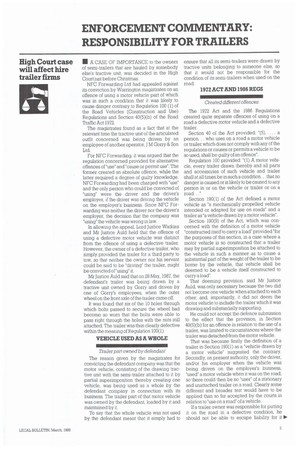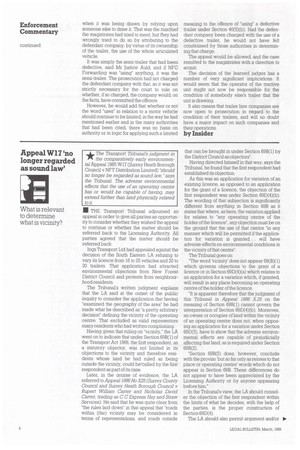High Court case will affect hire trailer firms
Page 121

Page 122

If you've noticed an error in this article please click here to report it so we can fix it.
II A CASE OF IMPORTANCE to the owners of semi-trailers that are hauled by somebody else's tractive unit, was decided in the High Court just before Christmas.
NFC Forwarding Ltd had appealed against its conviction by Warrington magistrates on an offence of using a motor vehicle part of which was in such a condition that it was likely to cause danger contrary to Regulation 100 (1) of the Road Vehicles (Construction and Use) Regulations and Section 40(5)(b) of the Road Traffic Act 1972.
The magistrates found as a fact that at the relevant time the tractive unit of the articulated outfit concerned was being driven by an employee of another operator, J M Corry & Son Ltd.
For NFC Forwarding, it was argued that the regulation concerned provided for alternative offences of "use" and "cause or permit use". The former created an absolute offence, while the latter required a degree of guilty knowledge. NFC Forwarding had been charged with "use" and the only person who could be convicted of "using" were the driver and the driver's employer, if the driver was driving the vehicle on the employer's business. Since NFC Forwarding was neither the driver nor the drivers employer, the decision that the company was busing" the vehicle was wrong in law.
In allowing the appeal, Lord Justice Watkins and Mr Justice Auld held that the offence of using a defective motor vehicle was distinct from the offence of using a defective trailer. However, the owner of a defective trailer, who simply provided the trailer for a third party to tow, so that neither the owner nor his servant could be said to be "driving" the trailer, might be convicted of "using" it.
Mr Justice Auld said that on 28 May, 1987, the defendant's trailer was being drawn by a tractive unit owned by Gorry and driven by one of Gorry's employees, when the outer wheel on the front axle of the trailer came off.
It was found that six of the 10 holes through which bolts passed to secure the wheel had become so worn that the bolts were able to pass right through the holes with the nuts still attached. The trailer was thus clearly defective within the meaning of Regulation 100(1).
VEHICLE USED AS A WHOLE Trailer part owned by defendant The reason given by the magistrates for convicting the defendant company was that the motor vehicle, consisting of the drawing tractive unit with the semi-trailer attached to it by partial superimposition thereby creating one vehicle, was being used as a whole by the defendant company in connection with its business. The trailer part of that motor vehicle was owned by the defendant, loaded by it and maintained by it.
To say that the whole vehicle was not used by the defendant meant that it simply had to ensure that all its semi-trailers were drawn by tractive units belonging to someone else, so that it would not be responsible for the condition of its semi-trailers when used on the road.
1972 ACT AND 1986 REGS Created different offences The 1972 Act and the 1986 Regulations created quite separate offences of using on a road a defective motor vehicle and a defective trailer.
Section 40 of the Act provided: "(5) a person. . . who uses on a road a motor vehicle or trailer which does not comply with any of the regulations or causes or permits a vehicle to be so used, shall be guilty of an offence".
Regulation 100 provided: ''(1) A motor vehicle, every trailer drawn thereby and all parts and accessories of such vehicle and trailer shall at all times be in such a condition.. . that no danger is caused or is likely to be caused to any person in or on the vehicle or trailer or on a road.. ."
Section 190(1) of the Act defined a motor vehicle as "a mechanically propelled vehicle intended or adapted for use on roads" and a trailer as "a vehicle drawn by a motor vehicle", Section 190(9) of the Act, which was concerned with the definition of a motor vehicle "constructed itself to carry a load" provided "for the purposes of this section, in a case where a motor vehicle is so constructed that a trailer may by partial superimposition be attached to the vehicle in such a manner as to cause a substantial part of the weight of the trailer to be borne by the vehicle, that vehicle shall be deemed to be a vehicle itself constructed to carry a load".
That deeming provision, said Mr Justice Auld, was only necessary because the two did not become one vehicle when attached to each other; and, importantly, it did not deem the motor vehicle to include the trailer which it was drawing and substantially supporting.
He could not accept the defence submission to the effect that the provision, in Section 40(5)(b) for an offence in relation to the use of a trailer, was limited to circumstances where the trailer was detached from the motor vehicle, That was because firstly the definition of a trailer in Section 190(1) as a "vehicle drawn by a motor vehicle" suggested the contrary. Secondly, on present authority, only the driver, and/or his employer when the vehicle was being driven on the employer's business, "used" a motor vehicle when it was on the road; so there could then be no "user'' of a stationary and unattached trailer OD a road. Clearly some different and broader test would have to be applied than so far accepted by the courts in relation to "use on a road" of a vehicle.
If a trailer owner was responsible for putting it on the road in a defective condition, he should not be able to escape liability for it II* when it was being drawn by relying upon someone else to draw it. That was the mischief the magistrates had tried to meet, but they had wrongly tried to do so by attributing to the defendant company, by virtue of its ownership of the trailer, the use of the whole articulated vehicle.
It was simply the semi-trailer that had been defective, said Mr Justice Auld, and if NFC Forwarding was "using" anything, it was the semi-trailer. The prosecution had not charged the defendant company with that, so it was not strictly necessary for the court to rule on whether, if so charged, the company would, on the facts, have committed the offence.
However, he would add that whether or not the word "uses" in relation to a motor vehicle should continue to be limited, in the way he had mentioned earlier and in the many authorities that had been cited, there was no basis on authority or in logic for applying such a limited meaning to the offence of "using" a defective trailer under Section 40(5)(b). Had the defendant company been charged with the use of a defective trailer, he would not have felt constrained by those authorities in determining that charge.
The appeal would be allowed, and the case remitted to the magistrates with a direction to acquit.
The decision of the learned judges has a number of very significant implications. It would seem that the operator of the tractive unit might not now be responsible for the condition of somebody else's trailer that the unit is drawing.
It also means that trailer hire companies are now open to prosecution in regard to the condition of their trailers, and will no doubt have a major impact on such companies and their operations.
by Insider
































































































































